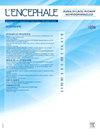Link between neurodevelopmental disorders and suicidal risk in children
IF 1.2
4区 医学
Q4 NEUROSCIENCES
Encephale-Revue De Psychiatrie Clinique Biologique et Therapeutique
Pub Date : 2025-02-01
DOI:10.1016/j.encep.2023.12.002
引用次数: 0
Abstract
Introduction
Suicide represents a significant public health issue among children and adolescents. However, in this population, while the literature seems to support a link between suicidal risk and neurodevelopmental disorders, there are still few studies on the subject. The psychopathological description of children who have realized a suicide attempt with a high potential for lethality, which can be defined as “serious”, appears to resemble that of children who have died by suicide. This study aimed to characterize the dimensional aspects of the neurodevelopmental profile of a population of children and adolescents hospitalized at Necker-Enfants–Malades Hospital for a serious suicide attempt.
Methods
This is an observational, prospective, and single-center study. Questionnaires for collecting general information and dimensional scales of neurodevelopment (Autism-Tics, ADHD, and Other Comorbidities Inventory, Social Responsiveness Scale, and Conners-3 for parents) were used. This study included 21 patients aged 9 to 15 years at the time of their hospitalization.
Results
The results supported the presence of at least one neurodevelopmental disorder (autistic traits, attention-deficit/hyperactivity disorder, learning disorder, or motor disorder) in 70% (n = 14) of the subjects, and at least one behavioral disorder (oppositional defiant disorder, conduct disorder) in 65% (n = 13) of these subjects.
Conclusion
The observed frequency of traits indicative of neurodevelopmental disorders in our population was higher than that observed in the general population, without the presented symptoms being eligible for categorical diagnosis. Considering the dimensional aspects of neurodevelopmental symptoms would therefore enable better identification of children at suicidal risk and more tailored interventions to contribute to the prevention of suicide in children.
神经发育障碍与儿童自杀风险之间的联系。
导言:在儿童和青少年中,自杀是一个重要的公共卫生问题。然而,尽管文献似乎支持自杀风险与神经发育障碍之间存在联系,但有关这一人群的研究仍然很少。自杀未遂儿童的心理病理特征与自杀身亡儿童的心理病理特征十分相似,前者具有很高的致死可能性,可被定义为 "严重"。本研究旨在描述因严重自杀未遂而在Necker-Enfants-Malades医院住院治疗的儿童和青少年的神经发育特征:这是一项观察性、前瞻性、单中心研究。调查问卷用于收集一般信息和神经发育维度量表(自闭症-抽动障碍、多动症和其他合并症量表、社交反应量表和针对父母的康纳斯-3量表)。这项研究包括 21 名住院时年龄在 9 至 15 岁之间的患者:结果:70%的受试者(14 人)至少患有一种神经发育障碍(自闭症、注意力缺陷/多动障碍、学习障碍或运动障碍),65%的受试者(13 人)至少患有一种行为障碍(对立违抗障碍、品行障碍):结论:在我们的人群中观察到的神经发育障碍特征频率高于普通人群,但所表现出的症状并不符合分类诊断的要求。因此,考虑神经发育症状的维度将有助于更好地识别有自杀风险的儿童,并采取更有针对性的干预措施来预防儿童自杀。
本文章由计算机程序翻译,如有差异,请以英文原文为准。
求助全文
约1分钟内获得全文
求助全文
来源期刊
CiteScore
4.60
自引率
7.40%
发文量
162
审稿时长
6-12 weeks
期刊介绍:
Une revue française de renommée internationale.
- Un comite de rédaction représentant tous les aspects de la prise en charge psychiatrique du patient.
- Une sélection rigoureuse d''articles faisant l''objet de plusieurs expertises.
- Des travaux d''auteurs et de chercheurs de renommée internationale.
- Des indexations dans les grandes bases de données (Current Contents, Excerpta Medica, etc.).
- Un facteur d''impact qui témoigne de la grande notoriété de la revue.
La tribune des publications originales de haut niveau.
- Une très grande diversité des sujets traités, rigoureusement sélectionnés à travers des sommaires dynamiques :
- des éditoriaux de médecins référents,
- une revue de presse sur les actualités internationales,
- des articles originaux pour approfondir vos connaissances,
- des mises au point et des cas cliniques pour engager votre réflexion sur les indications et choix possibles au travers de mises en situation clinique,
- des dossiers thématiques pour faire le tour d''une question.
- L''actualité de l''AFPB : L''Encéphale publie régulièrement des comptes rendus de l''Association française de psychiatrie clinique.

 求助内容:
求助内容: 应助结果提醒方式:
应助结果提醒方式:


